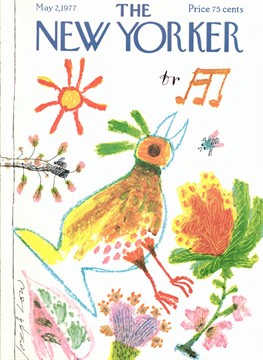The May 2nd, 1977 issue of The New Yorker, in which “The Kugelmass Episode” first appeared.
Responding to comments by Joe Adamson, Clayton Chrusch, and Matthew Griffin
Bob Denham points out that in the latter part of his career Frye virtually ceased using the word “archetype.” But, thanks at least to Anatomy of Criticism, it is a term that will always be associated with him — that third essay, “Archetypal Criticism: Theory of Myths” will likely remain a centerpiece, re-read and contemplated anew (not to mention misread and summarily dismissed) apart from everything else. But, of course, Frye is not really a modular thinker: you can’t take a small piece of him and say, “This is it in a nutshell.” The best you can do is to identify some aspect of Frye and extrapolate the rest of his critical outlook from it. (A. C. Hamilton, for example, claims that he can reconstruct all of Frye from a single phrase, the way a paleontologist might reconstruct an entire dinosaur from a bone fragment.)
This discussion thread began with the young Frye’s love of The New Yorker, so it’s nice bit of symmetry that we can return to the May 2nd, 1977 issue to round it out. In that issue, Woody Allen published what may be one of his best short stories, “The Kugelmass Episode” (the full text of which can be read here). In it, a humanities professor at CUNY named Kugelmass with an infatuation for Emma Bovary discovers a magician who can transport him into the novel where he becomes one of Emma’s lovers, and then snatches her away to attend the Academy Awards ceremony wearing a chic Ralph Lauren pantsuit (it’s 1977, remember). In a cutaway sequence, the scene briefly shifts:
“I cannot get my mind around this,” a Stanford professor said. “First a strange character named Kugelmass, and now she’s gone from the book. Well, I guess the mark of a classic is that you can reread it a thousand times and always find something new.”
That sense of finding “something new” in a work read “a thousand times” we might call the “Kugelmass effect.” It is suggestive of the fact that archetypes are constant but not reductive or static. They are expansively associative and ultimately unfold a vision of the world that, as Frye points out, is always “new” — however many times it has been rendered — because it has never been realized. It is what makes works of art “innocent” (as he puts in in The Educated Imagination), despite the cruel and unjust social conditions that produced them. It’s why we cannot read a work of literature just once and exhaust its imaginative possibilities. And it is surely why writers can and do (whether consciously or unconsciously, whether they freely admit to it or vehemently deny it) employ archetypes and still render them unique to the particular circumstances of the work at hand.
In Words with Power Frye explicitly identifies the literary experience as “visionary” and “prophetic.” But he’d always argued as much. To see the world in a grain of sand is to see everything in what is otherwise almost nothing, and to see it recreated in what is otherwise mundane. It is “primary concern” raised to the level of the “concrete universal” — everywhere, all at once, and all of the time.


This is a fantastic post, but I only have time right now to point out the default silhouette on the A.C. Hamilton link. It is extremely deformed.